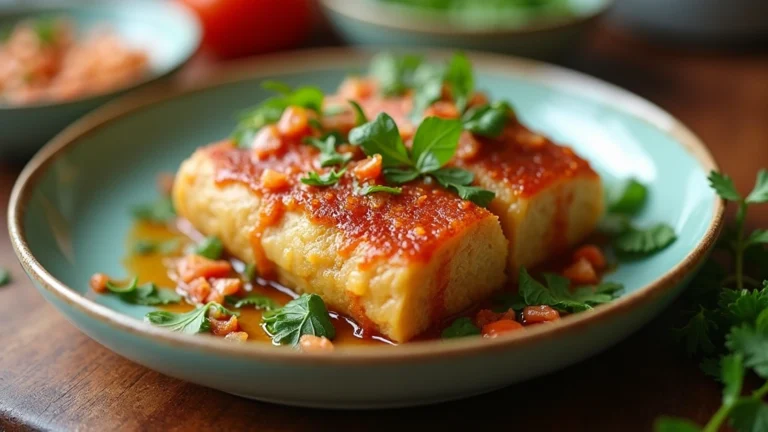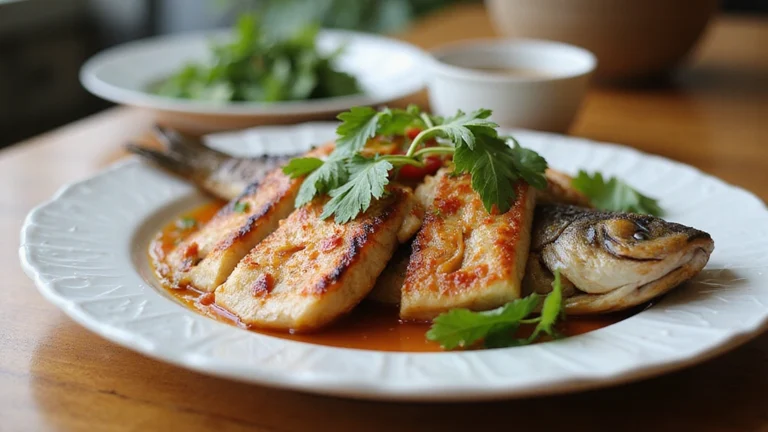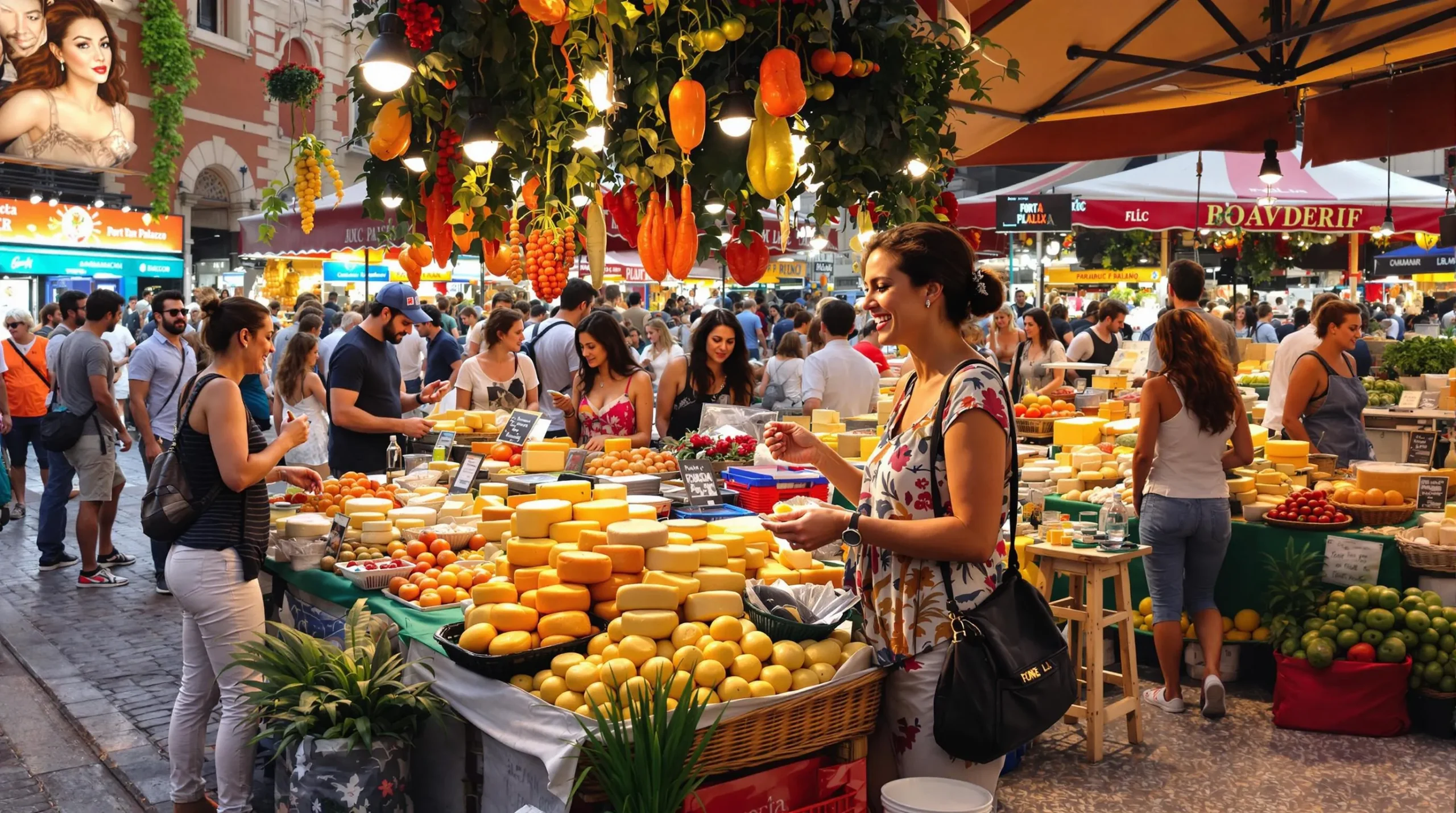
Discovering Foodie Torino: A Culinary Journey Through Turin
Turin unveils its gastronomic treasures to visitors willing to explore beyond the obvious tourist spots. Your culinary journey through this northern Italian city promises unforgettable flavors and authentic experiences that showcase why Turin deserves recognition as one of Italy’s food capitals.
Begin your exploration at Porta Palazzo Market, Europe’s largest open-air market where locals have shopped for fresh produce since 1835. Stroll through aisles of vibrant vegetables, artisanal cheeses and freshly baked breads while vendors call out their daily specials. The market opens early morning and buzzes with activity until early afternoon, offering the perfect opportunity to witness Turin’s food culture in action.
Next, treat yourself to Turin’s iconic coffee experience at historic cafés like Caffè Al Bicerin or Caffè Torino. These centuries-old establishments serve the famous bicerin, a layered drink of espresso, hot chocolate and cream that has warmed Torinese hands since the 18th century. During a recent visit, food writer Liam Kohn noted, “The ritual of sipping bicerin while watching the industry pass by from these ornate cafés captures the essence of Turin’s approach to food—deliberate, refined and meant to be savored.”
For lunch, venture into one of Turin’s traditional trattorias where Piedmontese specialties shine. Order agnolotti del plin, delicate pasta parcels pinched closed and filled with roasted meats, or tajarin, thin egg pasta typically served with butter and sage or ragù. These dishes represent the heart of Turin’s cuisine—simple ingredients transformed through careful technique.
Reserve your evening for aperitivo, Turin’s beloved pre-dinner ritual. The city claims to be the birthplace of this Italian tradition, and establishments throughout Turin honor it with spreads of small bites accompanying your vermouth or Campari-based cocktail. Popular spots like Caffè Elena in Piazza Vittorio Veneto offer generous buffets that sometimes eliminate the need for dinner altogether.
True food enthusiasts should not miss Turin’s chocolate heritage. The city’s chocolatiers have crafted gianduiotto—a soft chocolate and hazelnut confection—since the 1800s. Visit historic chocolate shops like Guido Gobino or Peyrano to sample these treats alongside other chocolate innovations that continue Turin’s sweet legacy.
For those seeking elevated dining experiences, Turin boasts several Michelin-starred restaurants where chefs reinterpret Piedmontese classics with modern techniques. Establishments like Del Cambio (founded in 1757) demonstrate how Turin’s cuisine continues to evolve while honoring its rich traditions.
Venture beyond the city center to discover Turin’s growing natural wine scene, where younger winemakers showcase Piedmont’s lesser-known grape varieties in casual enotecas. These venues often pair wines with simple plates highlighting local ingredients, creating approachable yet authentic dining experiences.
The Rich Culinary History Of Turin

Turin’s gastronomic heritage represents an exquisite fusion of royal court influences and humble local traditions. As the former capital of the Savoy Kingdom, Turin developed a distinctive culinary identity that continues to define its food scene today. Walking through the city’s historic center, you’ll discover a living museum of flavors where centuries-old recipes coexist with innovative culinary approaches.
Piedmontese Cuisine: The Foundation Of Foodie Torino
Piedmontese cuisine serves as the bedrock of Turin’s food culture, characterized by its deceptive simplicity and surprising depth of flavor. You’ll find dishes that celebrate seasonal ingredients prepared with meticulous attention to detail and respect for tradition. The region’s culinary philosophy emphasizes slow, mindful preparation techniques that bring out the natural qualities of each component.
Local specialties feature prized ingredients like the coveted white truffles from Alba, which transform ordinary dishes into extraordinary experiences. Rich risottos showcase the region’s commitment to perfect texture and flavor development. The cheeses of Piedmont deserve special attention, ranging from creamy Robiola to aged Castelmagno, each telling the story of its alpine origins.
Beyond Turin, the surrounding towns of Alba, Asti, and Bra contribute significantly to the region’s gastronomic reputation. Each locality offers distinctive specialties worth exploring. Dining in Turin provides you with access to this wider Piedmontese pantry, where robust wines perfectly complement the hearty yet refined cuisine.
The Slow Food Movement And Turin’s Influence
Turin holds a pivotal place in global food culture as the birthplace of the Slow Food movement. Founded in the early 1980s in nearby Bra by Carlo Petrini, this revolutionary approach emerged as a passionate response to fast food culture and industrialized eating habits. The movement’s core philosophy centers on “buono, pulito e giusto” – good, clean, and fair food production and consumption.
When you visit Turin, you’re experiencing the epicenter of a worldwide culinary movement that champions local producers, traditional food knowledge, and sustainable practices. The city regularly hosts the prestigious Salone del Gusto, a biennial international food fair that attracts culinary enthusiasts from across the globe. This celebration of gastronomic diversity showcases both traditional techniques and innovative approaches to food.
The influence of Slow Food permeates Turin’s dining scene, from neighborhood trattorias to upscale restaurants. You’ll notice the emphasis on ingredient sourcing, seasonal menus, and preservation of traditional recipes. Local chefs proudly share the stories behind their dishes, connecting you directly to the producers and the land.
Turin also hosts the renowned Cheese fair, dedicated to preserving dairy diversity and celebrating artisanal cheesemaking traditions. This event perfectly embodies the city’s commitment to protecting food biodiversity while supporting ethical production methods. Through these initiatives, Turin continues to shape global conversations about food ethics, sustainability, and the preservation of culinary heritage.
Essential Dishes For The Foodie Torino Experience
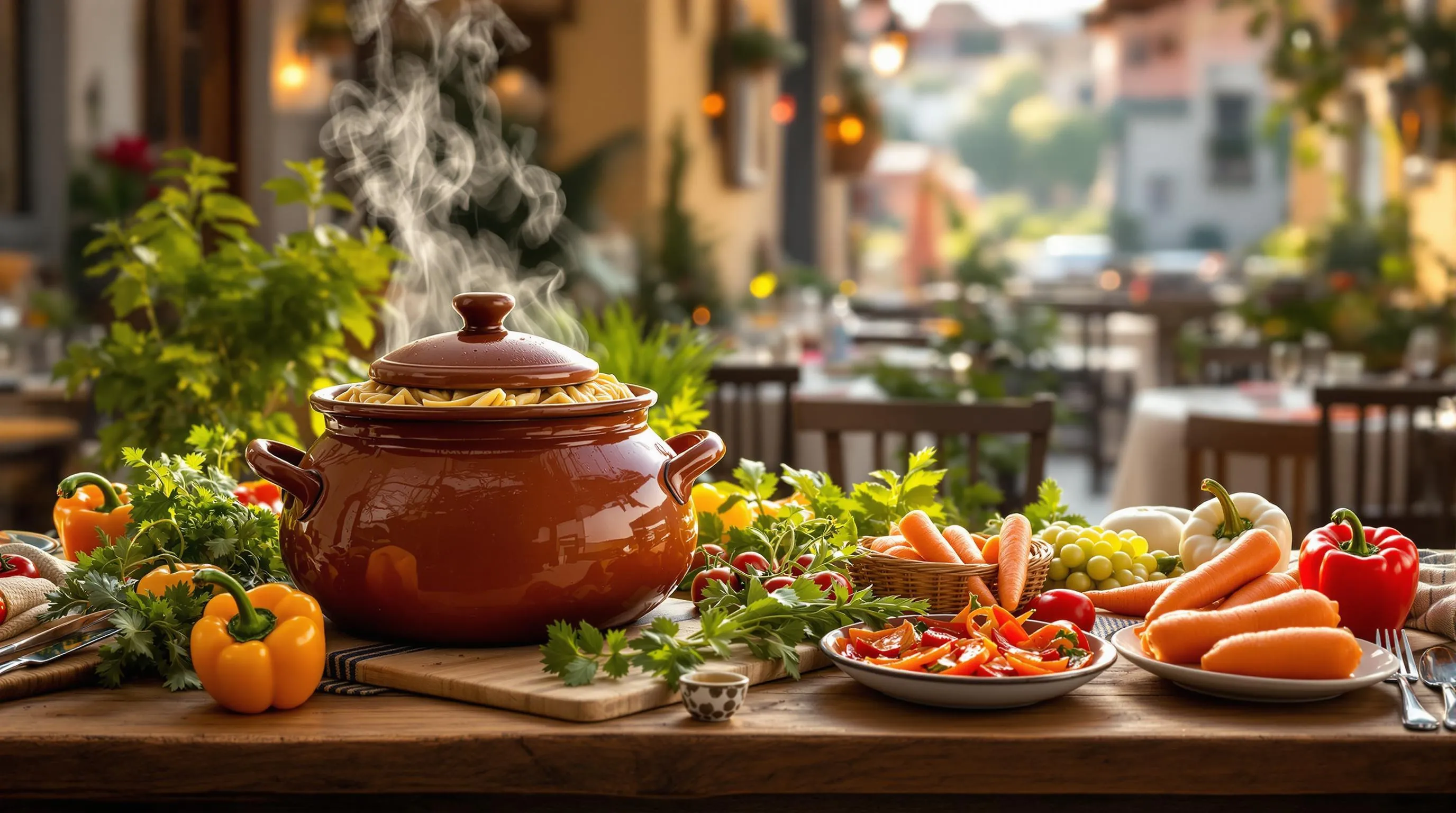
No food journey through Turin is complete without sampling its quintessential dishes that showcase the rich culinary heritage of Piedmont. These specialties offer you an authentic taste of the region’s gastronomic traditions.
The Art Of Agnolotti Del Plin
Agnolotti del Plin represents the pinnacle of Piedmontese pasta craftsmanship. These delicate pasta parcels derive their name from the local dialect word “plin” meaning “pinch” which describes the technique used to seal each pocket. You’ll find these delightful morsels traditionally filled with a savory mixture of roasted meats including veal pork and sausage all encased in thin egg pasta dough rolled to approximately 1/8 inch thickness.
The preparation requires meticulous attention to detail as each parcel must be pinched carefully to prevent trapping air inside. Local chefs often combine the meat filling with cheeses such as ricotta Parmigiano and Pecorino to create a harmonious flavor profile. When dining in Turin look for restaurants that serve these pasta gems with classic accompaniments like browned butter and sage or sometimes in a light flavorful broth.
The cooking process is brief but crucial – agnolotti should be cooked in salted boiling water for just 3-4 minutes until they float to the surface ensuring the perfect al dente texture. This dish exemplifies Turin’s commitment to pasta perfection and regional flavor integrity.
Vitello Tonnato: Turin’s Legendary Veal Dish
Vitello Tonnato stands as one of Piedmont’s most distinctive culinary creations showcasing the region’s sophisticated approach to flavor combinations. This refined cold dish features paper-thin slices of tender poached veal blanketed with a creamy sauce that brilliantly merges land and sea flavors.
The magic lies in the sauce a velvety emulsion of tuna capers and anchovies bound together with mayonnaise. This unlikely pairing creates a harmonious balance that has become a staple appetizer throughout Turin’s dining establishments. The contrast between the delicate veal and the savory umami-rich sauce offers you an unforgettable taste experience.
Traditionally served chilled Vitello Tonnato makes a perfect summer dish though locals enjoy it year-round. When you order this specialty in Turin you’ll often find it garnished with additional capers lemon wedges and perhaps a sprinkle of fresh herbs improving both presentation and flavor.
Bagna Càuda: A Communal Dipping Tradition
Bagna Càuda embodies the social heart of Piedmontese dining culture inviting shared experiences around the table. This warm anchovy garlic and olive oil dip transforms simple vegetables into vessels for rich savory flavors. The name itself translates to “hot bath” describing both its temperature and its role as a communal centerpiece.
You’ll find this aromatic dip traditionally served in a terracotta pot kept warm over a flame creating an interactive dining experience. The ritual involves gathering around the table with friends and family each person dipping seasonal vegetables into the fragrant sauce. Bell peppers carrots celery fennel and cardoons are particularly popular choices among locals.
The preparation remains remarkably simple yet the result delivers complex flavors. Garlic and anchovies melt together in olive oil creating a pungent savory foundation. Some Turin families maintain their own variations adding cream or butter for richness or red wine for depth.
This dish perfectly represents Turin’s approach to food where quality ingredients simple preparation and communal enjoyment come together. Experiencing Bagna Càuda offers you not just a taste of Piedmontese flavors but also insight into the region’s convivial dining philosophy.
Turin’s Chocolate Legacy
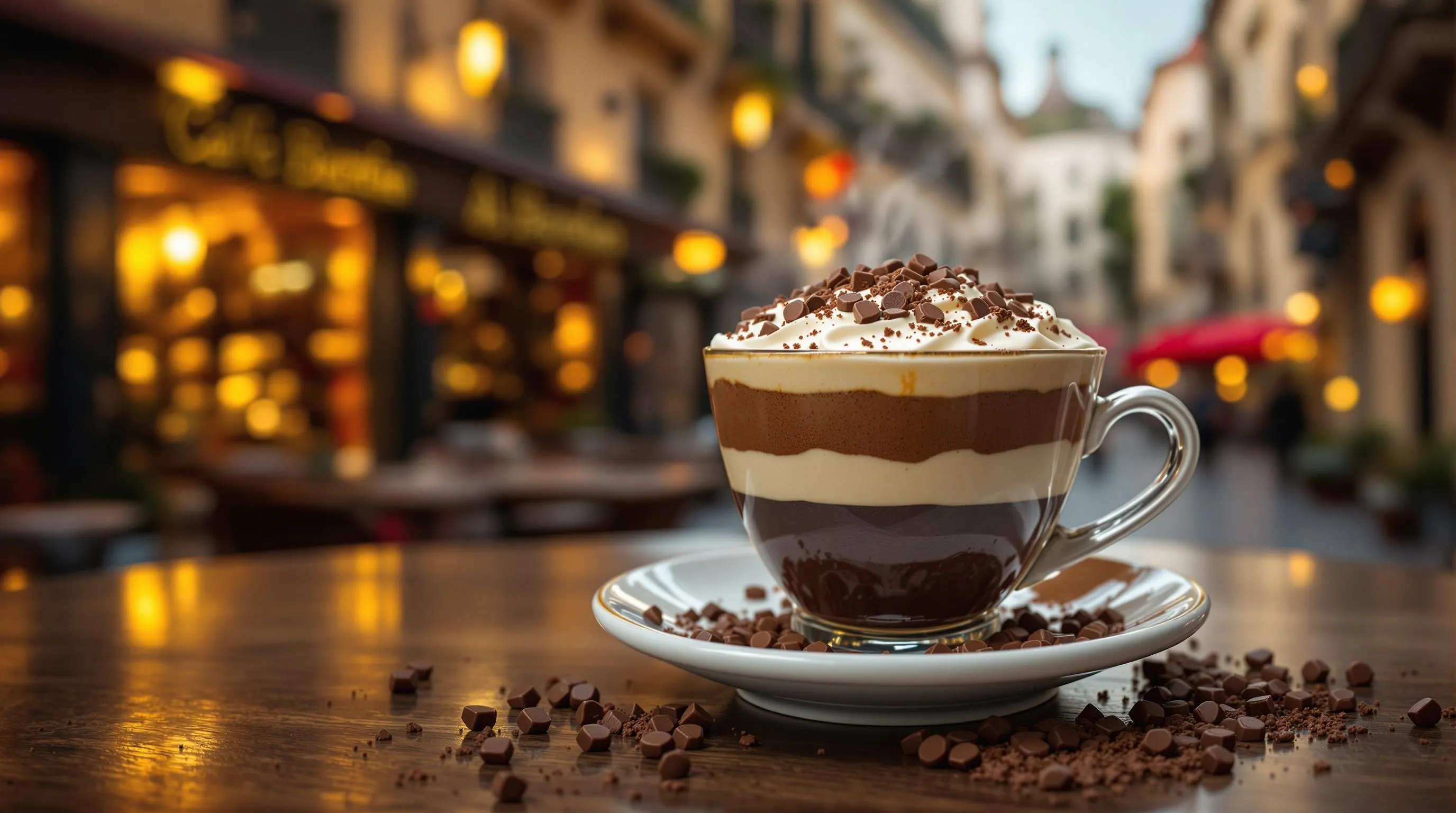
Turin stands as Italy’s chocolate capital with a sweet tradition dating back to the 16th century. The city’s chocolate culture began when Duke Emmanuel Philibert of Savoy introduced hot chocolate in 1559 establishing a legacy that continues to delight visitors today.
Bicerin: The Iconic Layered Coffee Drink
When you visit Turin a taste of bicerin becomes an essential experience for any food enthusiast. This signature beverage originated in the 18th century at Caffè Al Bicerin which opened its doors in 1763 and remarkably still serves this delicious drink in the same historic location today.
Your first sip of bicerin reveals its distinctive three-layer composition: rich dark chocolate at the bottom followed by strong espresso in the middle topped with velvety whisked cream. The drink comes presented in a small rounded glass allowing you to admire its beautiful layers before indulging.
Bicerin evolved from an earlier concoction called “bavareisa” which contained coffee chocolate milk and syrup all mixed together. The modern version distinguishes itself through precise layering and intense flavor profiles. Many Turin cafés offer variations featuring gianduia flavors incorporating the beloved chocolate hazelnut combination that locals particularly cherish.
Gianduiotto: Turin’s Famous Chocolate-Hazelnut Creation
The story of gianduiotto showcases Turin’s culinary innovation emerging from historical necessity. During the Napoleonic era cocoa shortages prompted chocolatier Michele Prochet to create something extraordinary by blending limited cocoa with finely ground hazelnuts from the nearby Langhe region.
You’ll recognize these iconic chocolates by their distinctive boat shape and golden foil wrapping. Prochet and Caffarel officially introduced gianduiotto in 1865 during Turin’s Carnival celebrations connecting the sweet treat with Gianduja a beloved commedia dell’arte character representing Turin’s cheerful spirit.
The secret behind gianduiotto’s melt-in-your-mouth texture lies in the exact hazelnut variety used – “Tonda Gentile delle Langhe” – which creates a creamy nutty paste requiring less cocoa while delivering exceptional flavor. This ingenious combination resulted in a chocolate that maintains its popularity more than 150 years later.
Exploring Turin’s chocolate shops allows you to sample countless variations of gianduiotto from traditional versions to modern interpretations. The confection remains a symbol of Turin’s confectionery mastery and represents the perfect edible souvenir to bring home from your foodie adventure in this northern Italian city.
Exploring Turin’s Food Markets
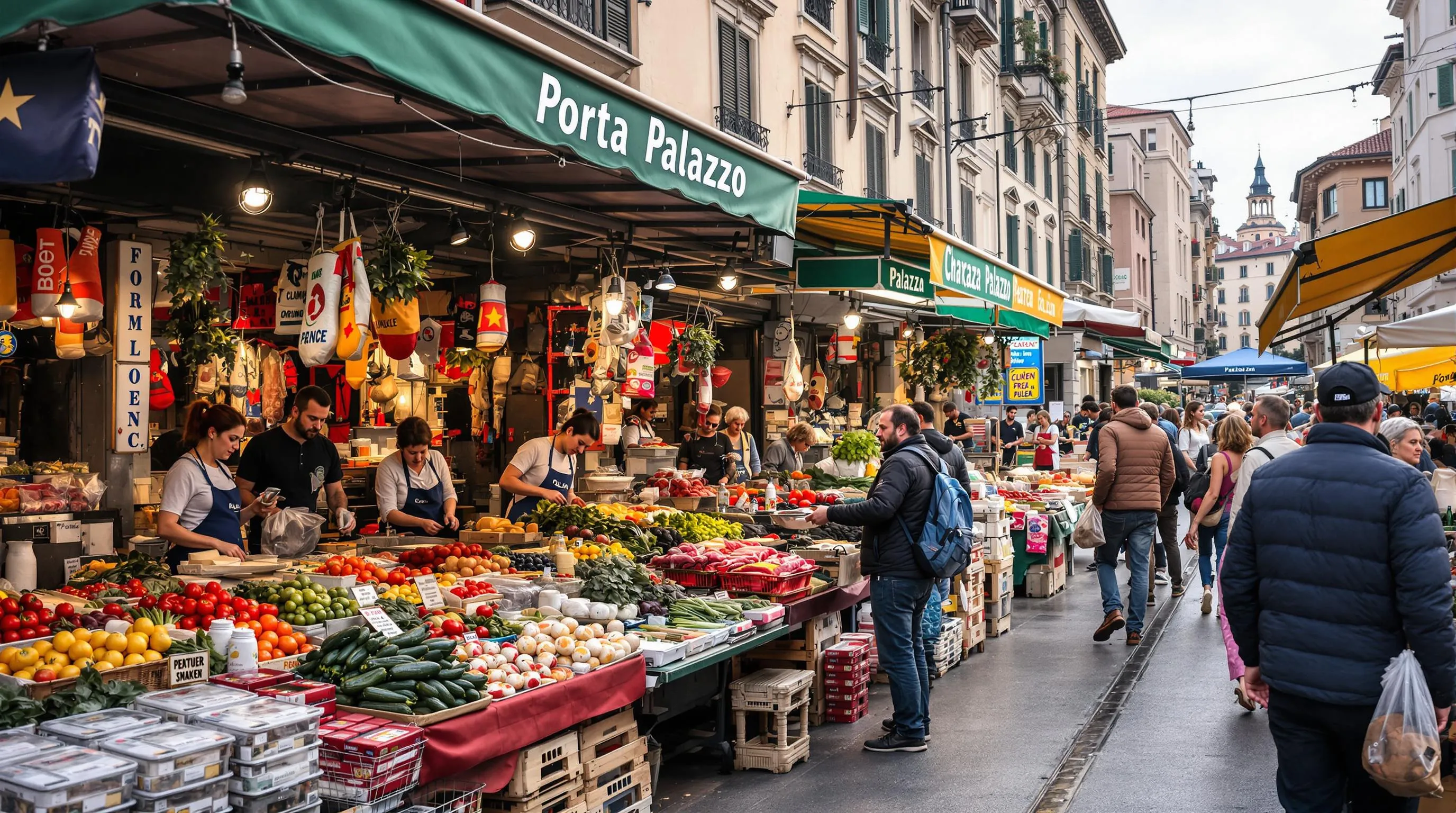
Turin’s markets serve as the beating heart of its culinary scene, offering visitors an authentic glimpse into local food culture and traditions. These vibrant marketplaces showcase the incredible diversity and quality of Piedmontese ingredients that form the foundation of the city’s renowned cuisine.
Porta Palazzo Market: Europe’s Largest Open-Air Market
When you visit Turin, Porta Palazzo Market should top your foodie itinerary as Europe’s largest open-air market. Established in 1835, this sprawling marketplace in Piazza della Repubblica has evolved into a multicultural culinary hub that perfectly captures Turin’s diverse food industry. The market is thoughtfully organized into four specialized zones, each offering distinct culinary treasures from fresh produce and artisanal cheeses to regional meats and exotic spices.
What makes Porta Palazzo truly special is its role as a meeting point for various food traditions. Local Piedmontese farmers sell alongside vendors from across Italy and international sellers from North Africa, Eastern Europe, South America, and Asia. This cultural tapestry creates an unforgettable sensory experience with aromas, colors, and flavors that tell the story of Turin’s evolving food identity.
The market operates Monday through Saturday, opening early morning until about 2 PM, though Saturday hours extend until 7:30 PM. Arriving early rewards you with the freshest selection and opportunities to watch locals expertly navigate the stalls, selecting the best ingredients for traditional recipes. Many Turin residents have maintained relationships with exact vendors for generations, demonstrating the market’s importance in daily life.
Mercato Di Campagna Amica: Farm-To-Table Treasures
For those seeking the purest expression of Turin’s agricultural bounty, Mercato di Campagna Amica offers a more intimate market experience focused exclusively on local, organic, and seasonal products. Located in the elegant Piazza San Carlo, this Saturday market connects you directly with farmers and producers from the surrounding countryside.
The market operates every Saturday from 9 AM to 2 PM, providing the perfect weekend opportunity to discover Piedmont’s agricultural richness. Unlike larger markets, Campagna Amica emphasizes sustainability and transparency, allowing you to speak directly with the people who grow and produce your food.
Walking through the stalls, you’ll find heirloom vegetables grown just miles from the city, artisanal cheeses made using traditional methods, and honey varieties that reflect the diverse Piedmontese landscapes. The market showcases the region’s commitment to preserving food traditions while embracing sustainable farming practices.
Many local chefs visit Mercato di Campagna Amica to source specialty ingredients for their restaurants, following the farm-to-table philosophy that has long been practiced in Piedmont, well before it became a global culinary trend. This direct connection between producers and consumers represents the core values of Turin’s food culture and the Slow Food movement that originated in this region.
Wine Culture In Foodie Torino

Turin stands as Piedmont’s capital and a magnificent destination for wine lovers seeking authentic Italian wine experiences. The city’s rich culinary heritage extends beyond food to embrace a diverse and sophisticated wine culture that reflects centuries of tradition.
Barolo And Barbaresco: The Kings Of Piedmontese Wine
No exploration of Turin’s wine scene is complete without encountering the legendary Nebbiolo-based wines that have earned worldwide acclaim. Barolo and Barbaresco reign supreme in Piedmontese viticulture both crafted exclusively from the noble Nebbiolo grape. These prestigious wines showcase remarkable structure aromatic complexity and exceptional aging potential with distinctive notes of rose tar and earth that evolve beautifully over time.
You’ll find Barolo often referred to as the “king of wines” due to its robust character and firm tannins that demand patience. Barbaresco the more elegant “queen” offers slightly more approachable qualities in its youth while maintaining impressive longevity. The picturesque Langhe hills where Barolo is produced and the Barbaresco region just northeast lie a short drive from Turin making them perfect day-trip destinations for wine enthusiasts visiting the city.
When dining in Turin’s traditional restaurants you can pair these magnificent wines with regional specialties that complement their complex profiles. Local sommeliers often recommend enjoying these wines alongside rich risottos hearty meat dishes or aged Piedmontese cheeses like Castelmagno and Robiola that highlight the wines’ nuanced characteristics.
Vermouth: Turin’s Historic Aperitif Tradition
Turin boasts an illustrious reputation as the birthplace of vermouth the aromatized wine that revolutionized aperitif culture throughout Italy and beyond. This distinctive fortified wine infused with local herbs and botanicals from the Alpine foothills represents a cornerstone of Turin’s drinking heritage that dates back to the late 18th century.
Antonio Benedetto Carpano created the first commercial vermouth in Turin capitalizing on the region’s access to diverse spices and the city’s position as a trading hub. Today vermouth remains deeply embedded in local culture appearing on menus across Turin’s historic cafés and bars. The traditional aperitivo hour serves as a daily ritual where locals and visitors alike gather to enjoy this aromatic drink often accompanied by small plates of regional delicacies.
You can experience authentic vermouth culture in Turin’s Quadrilatero district where establishments like Vineria i 3 Galli offer curated tastings featuring both historic and contemporary interpretations of this classic aperitif. The district buzzes with energy as patrons spill onto cobblestone streets during early evening hours creating the perfect atmosphere to immerse yourself in this quintessential Turin tradition.
When visiting Turin’s vermouth bars follow local custom by trying both red and white varieties either neat with a twist of citrus or in classic cocktails like the Negroni and Americano. This experience connects you directly to centuries of Turin’s distinctive drinking culture and offers insight into how the city’s wine traditions continue to evolve while honoring their historic roots.
Where To Eat In Turin
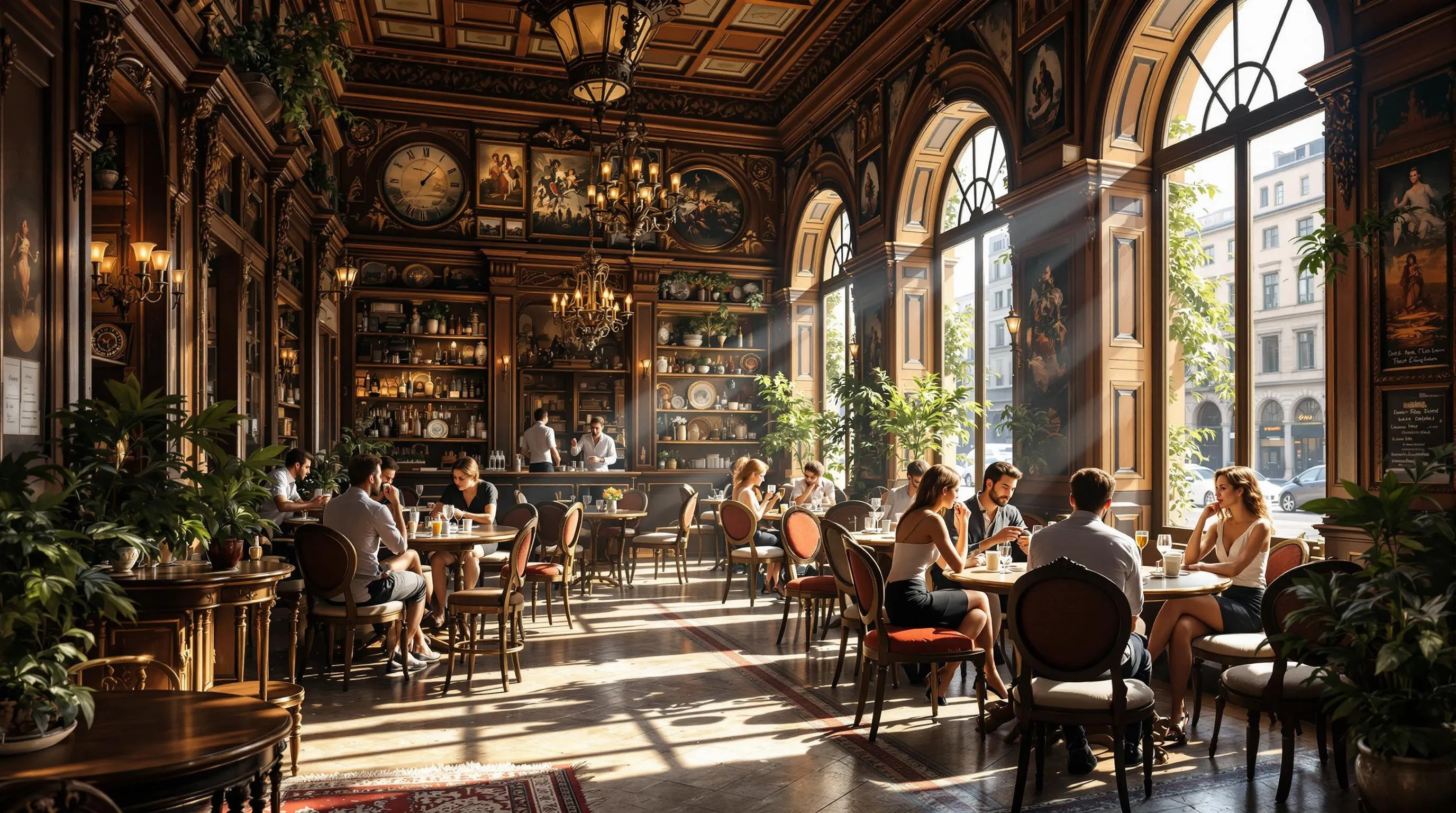
Turin, the capital of Italy’s Piedmont region, offers a ever-changing food scene that seamlessly blends historic establishments with contemporary hotspots. You’ll discover a culinary industry deeply rooted in Piedmontese traditions yet unafraid to innovate.
Historic Cafés And Restaurants
When exploring Turin’s historic dining establishments, begin at Caffè Torino, a landmark café that has been central to the city’s coffee culture since the 19th century. You must try their expertly crafted espresso or the local specialty bicerin—a decadent layered drink combining coffee, chocolate, and cream that exemplifies Turin’s café heritage.
For a truly special dining experience, visit Del Cambio, an institution dating back to 1757 that now boasts a coveted Michelin star. The restaurant’s opulent 18th-century dining room provides the perfect backdrop for sampling refined Piedmontese cuisine, with signature dishes like agnolotti alla piemontese showcasing local culinary traditions through their meticulously crafted tasting menus.
Farmacia del Cambio offers another historic dining option, housed in what was once an actual pharmacy. You’ll find traditional Piedmontese dishes with innovative touches served in a charming setting near Piazza Carignano, making it ideal for experiencing the evolution of local cuisine.
Complete your tour of historic eateries at Tre Galline, beloved for its rustic Piedmontese classics served in an atmosphere filled with antique charm. The restaurant provides an authentic glimpse into Turin’s culinary past while maintaining the quality and flavors that have made it a longstanding favorite.
Modern Foodie Torino Hotspots
The contemporary side of Turin’s food scene offers exciting options that respect tradition while embracing innovation. Wémá – Bogino stands out as a highly rated modern pizzeria where you can enjoy creative toppings in a lively atmosphere. Their fresh approach to pizza makes it popular with locals and visitors seeking quality casual dining.
For a sophisticated twist on Italian classics, head to Lobelix, known for its Mediterranean-influenced dishes. You’ll appreciate their contemporary dining experience that maintains an unwavering focus on quality ingredients while introducing fresh flavor combinations.
When you need a break from Northern Italian fare, Lao delivers authentic handmade Chinese steamed buns and soup dumplings that have earned it a devoted following. The restaurant provides a delicious contrast to the surrounding Italian eateries.
Madama Piola offers the perfect setting for a memorable date night with its vibrant atmosphere and inventive dishes that balance richness with creativity. You’ll find the restaurant buzzing with energy as diners savor their innovative takes on local cuisine.
For pasta enthusiasts, Pastificio DeFilippis showcases handmade pasta in a casual yet modern setting. The restaurant makes an ideal weekend lunch spot where you can appreciate the craftsmanship behind their freshly made pasta varieties while enjoying a relaxed dining experience.
Turin’s local trattorias and wine bars further enrich the dining industry. Trattoria Bar Coco’s charms with its unpretentious atmosphere and simple yet excellent dishes like their standout pasta e fagioli. Scannabue deserves attention for its authentic Piemontese cuisine paired with an extensive local wine list that showcases regional vintages. Caffè dell’Orologio successfully balances historic charm with modern sensibilities, offering traditional Piedmontese bar food alongside an impressive wine selection that highlights local producers.
Creating A Classic Turin Recipe At Home

Experience the authentic flavors of Turin cuisine by preparing a traditional dish in your own kitchen. Agnolotti al Plin, one of Turin’s most beloved pasta specialties, brings together simple ingredients with meticulous technique for a truly memorable meal.
Ingredients
- 2 cups all-purpose flour
- 3 large eggs (for pasta dough)
- 8 oz mixed meats (beef, pork, or veal), finely chopped
- 1 cup finely chopped cabbage
- 2 tablespoons fresh herbs (rosemary, thyme)
- 4 tablespoons butter
- 10-12 fresh sage leaves
- 1/2 cup freshly grated Parmigiano-Reggiano cheese
- Salt and pepper to taste
Directions
- Start by making your pasta dough. Form a mound with the flour on a clean surface and create a well in the center.
- Crack the eggs into the well and gradually incorporate the flour using a fork until a shaggy dough forms.
- Knead the dough for 8-10 minutes until smooth and elastic. Wrap in plastic and let rest for at least 30 minutes.
- Meanwhile, prepare your filling by combining the chopped meats, cabbage, and herbs in a bowl. Season with salt and pepper.
- Roll the rested dough into thin sheets using a pasta machine or rolling pin. Aim for a thickness where you can almost see your hand through the dough.
- Place small dollops (about 1 teaspoon each) of the meat filling along one half of the pasta sheet, leaving about 1.5 inches between each dollop.
- Fold the empty half of the dough over the filling and press firmly between the mounds to seal.
- Create the distinctive “plin” by pinching the pasta between each mound of filling with your thumb and index finger.
- Cut between each pinch with a pasta wheel to create individual agnolotti.
- Bring a large pot of salted water to a boil and cook the agnolotti for 2-3 minutes until they float to the surface.
- While the pasta cooks, melt the butter in a large skillet and add the sage leaves, allowing them to crisp slightly and infuse the butter.
- Gently drain the cooked agnolotti and transfer them to the butter sauce, tossing carefully to coat without breaking the delicate pasta.
Serving Suggestions
Plate your agnolotti al plin while still hot, arranging them in a single layer and spooning any remaining butter sauce over the top. Sprinkle generously with freshly grated Parmigiano-Reggiano cheese before serving. Pair this traditional Turin dish with a glass of regional Piedmontese wine such as Barbera for reds or Gavi for whites to complement the flavors authentically. Consider serving smaller portions as a primo piatto (first course) followed by a light secondi of seasonal vegetables or meats. The dish works beautifully for both casual family dinners and special occasions, embodying the rustic elegance that defines Turin’s culinary identity.
My Foodie Torino Experience: A Personal Journey
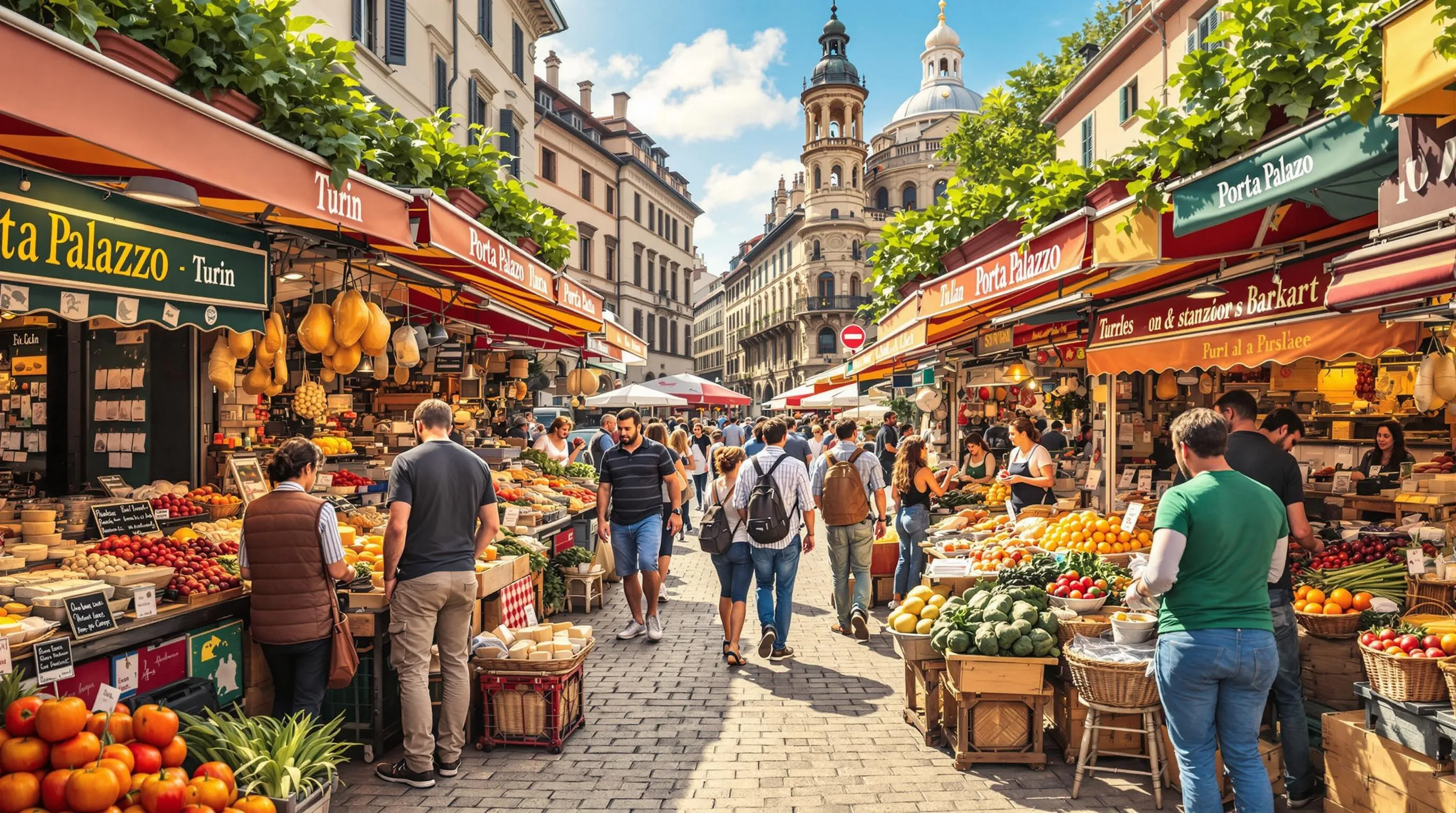
Stepping off the train at Porta Nuova station introduced me to Turin’s culinary magic beyond anything I had imagined. The city welcomed me with its distinctive aromas of freshly baked grissini and chocolate wafting through narrow streets lined with elegant arcades. My first morning began at a historic café where I savored my first authentic bicerin—that heavenly layered drink of espresso coffee chocolate and cream that has fueled Turinese conversations for centuries.
Wandering through Porta Palazzo Market truly awakened my senses to Turin’s vibrant food culture. Established in 1835 this sprawling marketplace buzzes with locals haggling over plump tomatoes artisanal cheeses and freshly harvested white truffles from nearby Alba. Vendors called out in Piedmontese dialect creating a symphony of sounds that complemented the visual feast before me. I found myself lost among stalls of seasonal produce stopping frequently to sample regional specialties offered by proud producers.
The revelation of tajarin pasta changed my understanding of Italian cuisine forever. These thin hand-cut egg noodles indigenous to Piedmont possess a delicate texture that perfectly captures the essence of simple yet sophisticated Turinese cooking. At a family-run trattoria tucked away from tourist paths I watched in awe as an elderly nonna rolled and cut the pasta with practiced precision before serving it with a light dusting of local white truffles.
Turin’s chocolate heritage proved impossible to resist during my journey. The city’s status as Italy’s chocolate capital since the 16th century manifests in every chocolatier’s window display. I discovered the joy of gianduiotto—those distinctive boat-shaped chocolates blending fine cocoa with local hazelnuts—created during Napoleon’s continental blockade when cocoa was scarce. Each silky smooth piece melted on my tongue revealing complex flavors that spoke of Piedmont’s terroir.
Bagna càuda transformed my perception of communal dining one chilly evening. This warm anchovy and garlic dip bubbling in a terracotta pot surrounded by fresh vegetables encouraged conversation and connection with fellow diners. The ritual of dipping crisp bell peppers celery and cardoons into the fragrant sauce while sipping Barbera d’Asti embodied the Piedmontese philosophy that good food should bring people together.
My culinary exploration reached new heights during Turin’s aperitivo tradition. Each evening around 6 PM the city’s residents gather in historic cafés and modern bars to enjoy pre-dinner drinks accompanied by generous buffets. I discovered vermouth in its birthplace sipping the aromatic fortified wine while sampling an array of small bites from fritto misto to local cheese platters. This daily ritual highlighted Turin’s perfect balance between elegance and accessibility.
Venturing beyond the city center revealed Piedmont’s dedication to sustainable food practices. At Mercato di Campagna Amica I connected directly with farmers selling organic seasonal produce harvested that morning. This farm-to-table approach reflects Turin’s position as the birthplace of the Slow Food movement which champions local production methods and traditional food knowledge. Speaking with producers about their cultivation techniques deepened my appreciation for Turin’s commitment to preserving culinary heritage.
The unexpected joy of discovering Japanese influence within Turin’s food scene surprised me. Local restaurants have embraced sushi and poke bowls while maintaining their Italian identity highlighting the city’s openness to culinary evolution. This fusion of traditions demonstrates how Turin continues to develop its food identity while honoring its gastronomic roots.
Conclusion: Why Turin Deserves Its Place On Every Food Lover’s Bucket List
Turin stands as Italy’s unsung culinary hero where centuries of tradition meet innovation in every bite. From the bustling stalls of Porta Palazzo to the refined elegance of Michelin-starred restaurants this northern Italian gem offers an authentic food experience that’s refreshingly free from overtourism.
What makes Turin truly special is how food weaves through the fabric of daily life. Here the Slow Food movement was born chocolate was perfected and vermouth created—all while maintaining a genuine connection between producers and consumers.
As you plan your Italian adventures look beyond the obvious destinations. Turin awaits with its bicerin-filled cafés tajarin-serving trattorias and gianduiotto-filled chocolate shops—promising a gastronomic journey that satisfies both your appetite and your soul.
